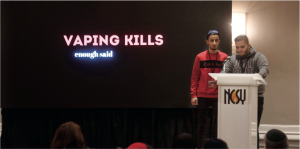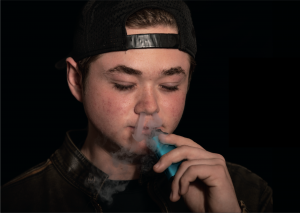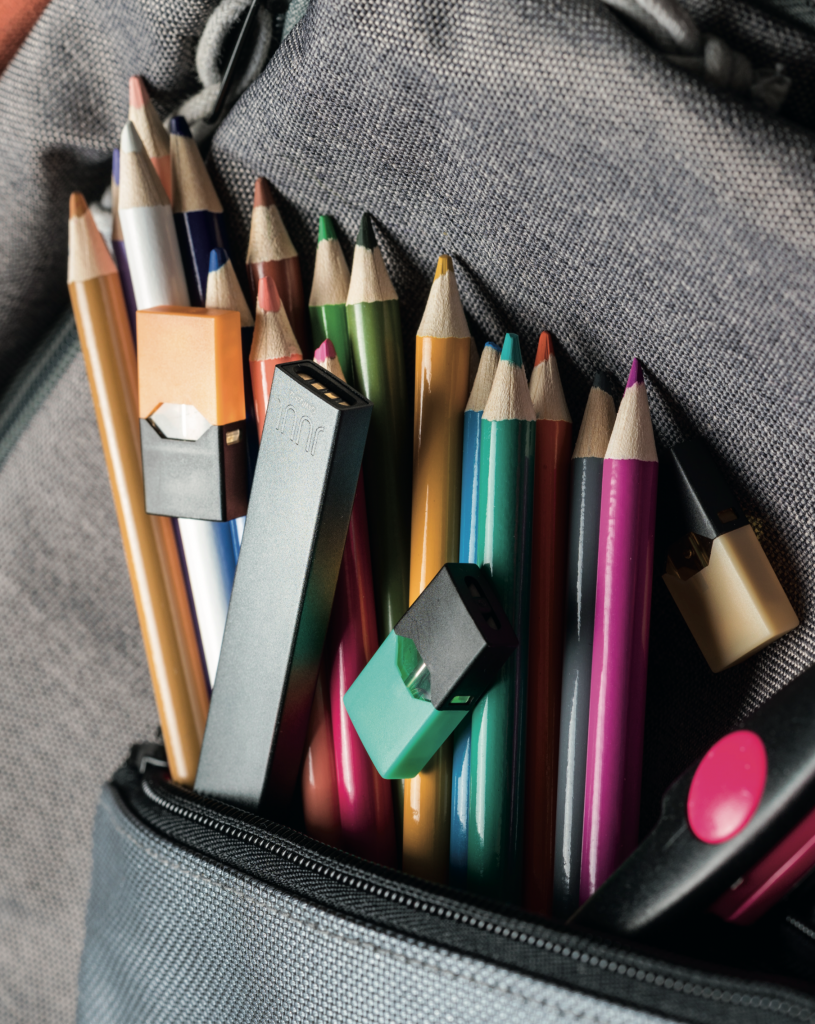Nicotine Is Back. Now What?
Ari* doesn’t remember why he began vaping when he was twelve. But by the time he started high school at a New York-area yeshivah, he was addicted to nicotine.
“I used to do it every day,” he says of his e-cigarette habit. “I would wake up in the morning and take a hit. I always had it on me. If I didn’t, it was like forgetting my phone—I felt like I was missing something.”
Now seventeen, Ari has quit vaping. “It got to the point where I couldn’t focus without it,” he says. “I didn’t want this thing in my life. I didn’t want to grow up and be a dad with a nicotine addiction.”
E-cigarettes are battery-powered devices that heat a liquid to convert it to vapor, which is inhaled. The liquid may contain nicotine, flavored glycerin or THC (the active ingredient in marijuana), in addition to other chemicals.
One vape pen, the Juul, has exploded in popularity in recent years, so much so that “Juuling” is now commonly used as a verb. The Juul is rechargeable, looks somewhat like a USB stick and is designed to evoke the sensory experience of smoking a cigarette. One Juul liquid cartridge, or “pod,” contains as much nicotine as a pack of cigarettes.
$38,000,000,000: According to the New York Times, at the end of 2018 Juul Labs was valued at $38 billion, more than the Ford Motor Company.
Until recently, Juul pods came in a variety of flavors that appealed to young people. After negative media attention in the summer—when dozens of young people were hospitalized with mysterious lung ailments linked to vaping—the company limited its flavors dramatically.
In 2017, Rabbi Maury Grebenau, principal of Yavneh Academy of Dallas high school, noticed a lot of chatter among the students about vaping. “I knew I needed to educate myself about this,” he recalls, “but I couldn’t find much out there.”
He began to research vaping so he could help guide the staff, students and parent body. What Rabbi Grebenau found alarmed him. “It’s very scary stuff,” he says, “and most people don’t know much about this, since it’s relatively new. The research is clear that vaping is harmful; many of the long-term effects aren’t yet known. There are a lot of question marks.”
Rabbi Grebenau says society has been slow to understand the severity of the situation among teens. And it quickly became apparent to him that Jewish educators around the country were desperate for any information on the subject. “After I wrote a blog post about vaping, people sought me out because I seemed to know something about it. It became clear to me that this problem is much more significant in the Orthodox community than I had realized. And it is clearly not a fad that’s going away.”
The national Monitoring the Future survey of eighth, tenth and twelfth graders, administered annually since 1975 by the National Institutes of Health (NIH), showed that rates of e-cigarette use doubled in the past two years. In 2019, more than one in four students in twelfth grade said they had vaped nicotine within the past month. Among tenth graders, the number was one in five.
FACT: Nicotine exposure can harm brain development.
Clearly, the Orthodox community is not immune. “When it comes to e-cigarettes and teens, the Orthodox community is catching up to everyone else,” says Dr. Hylton Lightman, who has served as a pediatrician in Far Rockaway, New York for more than thirty years. “Fortunately, with other types of substance abuse we’re lagging behind the general population, but not with this.”
Even more troubling, public health research indicates that vaping may serve as a gateway, predisposing teens to other risky behaviors. “It is clear that vaping leads to using other substances,” says Dr. Lightman.
After examining the research, Rabbi Grebenau has come to that conclusion as well. “Teens who vape have an increased chance of using marijuana or cigarettes.”
Noah* is a tenth grader at a yeshivah high school in the Midwest who vapes every day. He doesn’t believe Juuling will lead kids to smoke cigarettes. “Switching from Juuling to cigarettes would be switching from something convenient to something that’s a hassle,” he explains. “Why would you bother?” He and his friends agree, however, that “if you already [vape] a Juul, you’d probably also be the type of kid who would smoke weed.”
Because . . . Why Not?
Dr. Lightman believes teens gravitate toward vaping because it seems “innocuous.”
Rabbi Grebenau concurs. “It doesn’t have the psychological barriers of cigarettes,” he says. “Cigarettes cause yellowing of the teeth and nails, and they smell bad. When kids are offered a vape, they think, ‘How bad could it be? It’s candy apple!’” In fact, last year’s Monitoring the Future study concluded that many teens associate little risk of harm with vaping.
Dr. Lightman stresses that medical research has shown that “nicotine affects the developing brains of adolescents.” Once the brain changes, it can continually crave nicotine. Furthermore, the additives in e-cigarette liquid are “quite toxic and can cause lung damage and even death.”
Even those teens who are informed of the danger may be pulled in. Sarah* is a twelfth grader at a Modern Orthodox girls’ high school. She says she and her peers are aware of the medical risks of vaping, “but it doesn’t stop me. I just think it won’t happen to me.” She began vaping in tenth grade when a friend shared her Juul. Sarah eventually bought her own. “Juuling is appealing at first because of the physical pleasure you get from the nicotine buzz,” she explains, “and after that you get addicted.” Sarah now vapes “every day, multiple times a day.”
When kids are offered a vape, they think, ‘How bad could it be? It’s candy apple!’
Ari feels growing up is “stressful and hard for teenagers. Vaping takes away the stress for five seconds, so you keep doing it. And then it becomes an addiction.”
Noah began vaping “mostly because everyone around me was doing it. It’s cool looking. It tastes good. And it feels good,” he says. “It gives me a head rush, like a light-headed feeling but in a good way.”
For Noah and his friends, vaping also alleviates boredom. “It’s like playing with fidget spinners or chewing gum,” Noah explains.
Dr. Lightman highlights that boredom is, in fact, a serious factor in the widespread vaping use among teens. “Kids today are primed to need stimulation and thrills. This is most definitely connected to the use of technology. Teens gravitate to a Juul as they do to any other device. They don’t consider how harmful it can be, because it is freely available all around them.”

Ezra Academy high school students Nissim Mushayev (left) and Michael Rubin introduce their team’s anti-vaping initiative at NCSY JUMP’s Create-a-Thon competition this past November. JUMP (Jewish Unity Mentoring Program) is NCSY’s National Leadership Program that trains and empowers high school students from all over the United States to become leaders. Photo: Etan Vann
Indeed, e-cigarettes have become so ubiquitous that experts say it’s unlikely an Orthodox kid won’t encounter them. “If anyone says it’s not in their school,” says Dr. Lightman, “they are unfortunately not in touch with reality or their student body. And it’s happening in elementary school, not just in high school.”
“It makes no difference whether they are boys or girls, cool or not cool, less observant or more observant,” says Rina Emerson, managing director of National NCSY and CEO of New York NCSY. “It’s a problem across the board.
“Vaping is also different, in a significant way, from other substances that teens experiment with,” adds Emerson. “When teens are drunk or high, or even smell of smoke, we know what they’ve been doing. But there is almost no way to detect if someone has been vaping. It’s much less clear-cut than other substances we have dealt with. And I think that the ambiguity is appealing to teens. It’s also cheap and accessible, which makes it even more attractive to them. And there is a lot of misinformation; no one seems to know why vaping is bad, or if it’s bad, other than the fact that it’s illegal if you’re under-age.”
Though many states have recently raised the legal age for buying vaping products from eighteen to twenty-one, teens have no trouble buying these products at local shops. “If you go in with someone and they know him, they will sell to you too,” Noah explains. “They don’t card and they don’t care.”
Sarah agrees. “Some places don’t ID, so I’ll go there,” she says. “Or I’ll get a friend [of legal age] to go for me.” Ari also asks other people to buy vaping products for him.
Uncharted Territory
“Many parents struggle with parenting teens,” says Rabbi Grebenau. “This is not a new problem. What is different here is the lack of knowledge about what we are dealing with. For example, a student was found in school with vape pods containing a quantity of nicotine equivalent to twelve packs of cigarettes. It was clearly a serious problem, but when we spoke to the parents, they responded that they had not known what vaping was until they Googled it. They lacked an understanding of what was going on with their child.”
“In my practice, some parents know what’s going on and some don’t,” says Dr. Lightman.
Noah is upfront with his parents about his vaping. “My parents feel I am responsible for my actions,” he says. “They also know they can’t really take away my Juul. It’s just thirty-one dollars to buy a new one. They took away my brother’s, but he bought another one.”
FACT: Most tobacco use is established during adolescence.
In fact, by the time many teens are caught vaping, they are already addicted to nicotine. Therefore, confiscating a Juul from a teen may not be a productive approach.
“My friends say they’re going to stop,” says Ari. “They’ve even thrown away their Juuls. But then they get another. I’ve personally had three.” He reports experiencing panic attacks, increased hunger and headaches when he quit. To cope, he took up running, “to fill in that space with something healthy.”
Noah quit vaping briefly in the summer. He feels that giving it up is doable. “It’s all about willpower,” he says. “When I stopped, I had cravings and headaches from nicotine withdrawal. But if the Juul wasn’t on me, I did nothing.” He says it took about a month to adjust. Unfortunately, he did go back to his habit.
Dr. Lightman emphasizes that there is no question that parents should be proactive. (See “Could Your Child Be Vaping? What Every Parent Needs to Know” on the following page.)
In Search of a Solution
“We have seen vaping bring nicotine addiction back into the high school population when it was all but gone,” says Dr. Rivka Schwartz, associate principal, general studies, at SAR High School in Riverdale, New York. As coordinator of Machon Siach, SAR’s research arm, she is leading what has become known as The Yeshiva League Substance Use Initiative.
The initiative began with the New York-area high schools that play sports in the Yeshiva League, Dr. Schwartz explains. “This encompasses a range of kids who socialize with each other. They hang out together, go to camp together, spend Shabbos together. It’s clear that whatever happens with kids in one school isn’t happening in a vacuum.”
“Our initial thoughts were that we should leverage the collective energies of schools across the community,” explains Rabbi Tully Harcsztark, principal of SAR High School and dean of Machon Siach. The group of principals met and, in their research, came across a study from Reykjavik, Iceland, addressing teen drinking. In 1996, Reykjavik discovered that there was a significant alcohol problem in its teen population. A survey at the time showed that 42.5 percent of the city’s teens had recently gotten drunk. In 2014, the number was down to 5 percent. What happened? The city used a multi-pronged approach, including surveys, pledges from parents to commit to increased quality time and curfews, and government-sponsored social programming to alleviate teen boredom. Ultimately, the approach resulted in genuine cultural change.
“[This] felt very compelling to us and oriented our work from that point onward,” says Rabbi Harcsztark.
Machon Siach engaged a national research firm to conduct a survey of Orthodox high school students modeled after Monitoring the Future. On February 27, 2019, approximately 3,600 students from nineteen schools—mostly in the New York/New Jersey area—sat and filled in pages of Scantron® bubbles.
“This isn’t a question of one school, one type of school or even one substance,” says Dr. Schwartz. “It’s about the culture of substance use among our kids. What is it centered around? How is it happening?”
Dr. Schwartz clarifies that the survey was not about substance abuse per se. “Rather, the focus was specifically on teen use of substances, be it smoking, alcohol or drugs, in the context of socializing. We are all talking about this problem, but truthfully we have no idea what we’re talking about. We had to learn.”
Interestingly, Dr. Schwartz points out that there is no other undertaking where yeshivah high schools are working together toward a bigger goal. “Our unity and shared purpose are part of the strength of this effort,” she notes. In fact, the group made a firm decision not to separate data by school. “It’s possible we would see different trends for different schools, but we gave up on that for the sake of community. We are all in this together.”
If anyone says it’s not in their school, they are unfortunately not in touch with reality or their student body. And it’s happening in elementary school, not just in high school.
The group plans to carry out the survey annually, with the goal of observing trends over time. What to do with the data, however, is a more tenuous conversation. The recommendation would be to launch a research-based public health effort to mobilize the Jewish community to address substance use in its midst. “It’s an undertaking that can potentially take up to ten years to be fully operative and show results,” says Dr. Schwartz. “But we don’t do a lot on that time scale in our community.” With many institutions in the Jewish community operating on year-to-year budgets, Dr. Schwartz believes there needs to be broader support and buy-in from the community to achieve a long-term initiative.
In the meantime, Dr. Schwartz says SAR has been taking short-term measures to address the issue within the school—as have most Orthodox high schools. At Yavneh Academy, Rabbi Grebenau installed vape detectors in certain areas on campus, and he invites a substance use expert to speak to the students a few times a year. Virtually all Jewish high schools have policies in place regarding e-cigarette usage.
For its part, NCSY doesn’t allow e-cigarettes at any of its programs. “Teen vaping is illegal,” says Emerson. “We take that seriously and treat it like anything teens are doing that is illegal.”
The Shabbat Factor
There is one significant vaping issue that is unique to Orthodox teens: Shabbat.
“Before I quit vaping, I didn’t keep Shabbat,” Ari admits. “I needed it so badly. I didn’t use my phone on Shabbat, but I used my Juul.”
Sarah also says she vapes on Shabbat, “just not as much, because I feel guilty.”
Ultimately, says Emerson, “at our NCSY programs, we deal with vaping on Shabbat the same way we deal with Shabbat in general. We address it in context: What’s the kid’s background? And which is the bigger problem—the addiction or the chillul Shabbat?”
Dr. Schwartz maintains that the community must have bigger conversations than how schools and programs are policing teens. “We have potential to be more effective than ‘who gets caught’ and ‘how do we punish?’” she says. “We need to be discussing how we deal with the culture in a much broader sense if anything is going to change.”
FACT: When OU Kosher was approached by e-cigarette companies seeking to certify their flavored liquid pods, it made the decision not to certify manufacturers of e-cig products.
Interestingly, sometimes kids themselves can motivate one another to change. What led to Ari’s decision to quit vaping? His younger brother. “My little brother is fifteen,” Ari says. “He saw me doing it. He saw his friends doing it. Now he does it, and I hate that he does. I sat him down and said, ‘Don’t start. You don’t want this thing in your life.’
“I think teens have to go through this,” Ari adds philosophically. “Trying to enforce ‘straightness’ in teenagers doesn’t go over well. We have to find out for ourselves.”
“This is an uphill battle,” concludes Dr. Schwartz. “It’s everywhere. But fighting uphill battles is what we do [in Orthodox high school education]. We’re trying to convince our kids to opt in, when society gives them every reason to opt out. We are countercultural in everything we are teaching these teens. This is one more way.”
* All names of students have been changed.
Rachel Schwartzberg works as a writer and editor and lives with her family in Memphis, Tennessee.
More in this Section: Is Vaping Kosher?

Anti-vaping flyers created by the Ezra Academy JUMP team, designed to be hung in schools and shuls to raise awareness. They are available via the team’s Instagram account, vaping_killz. Courtesy of Rabbi Tzachi Diamond
#Vaping_killz
By Rachel Schwartzberg
This past November, NCSY hosted a JUMP Create-a-Thon in Stamford, Connecticut, bringing together fourteen teams from high schools across the US and Canada. JUMP (Jewish Unity Mentoring Program) is NCSY’s leadership program that trains and empowers high school students from all over the United States to become leaders.
In a hackathon style event, teams were tasked with identifying an issue plaguing the Jewish teen community and coming up with actionable solutions. The team from Ezra Academy in Queens, New York—Ellea Harkins, Gabby Davidov, Michael Rubin and Nissim Mushayev—selected vaping as their area of concern.
“Jewish teens are plagued by this problem,” explains Rabbi Tzachi Diamond, who works for New York NCSY and serves as the faculty advisor for the JUMP team from Ezra Academy. “The team hopes to bring awareness to try to prevent kids who are beginning to vape or have not yet begun. They are working to make it cool not to vape.”
The three-day Create-a-Thon culminated with each team presenting brief pitches to a panel of judges. Three winning teams were awarded micro-grants from NCSY to help implement their plans. Ezra Academy’s team members won the top grant for their Vaping_Killz campaign.
The teens created posters to hang in schools and shuls to bring about awareness of the issue. They are working on several other initiatives, including a school “buy-back” program for vaping devices and meetings with a company that manufactures vape detectors. They are also reaching out to other Jewish high schools and to Jewish organizations that address substance abuse in the hope of collaborating to bring the issue to the fore.
“They know they’re not the first ones to address this issue,” says Rabbi Diamond. “But they feel if they can save just one life, it’s all worthwhile.”
 Could Your Child Be Vaping? What Every Parent Needs to Know
Could Your Child Be Vaping? What Every Parent Needs to Know
How should a parent of a teen address the issue of vaping?
By Rachel Schwartzberg
Try to get in front of the problem. “Prevention is better than intervention,” says Far Rockaway pediatrician Dr. Hylton Lightman.
Educate yourself. Know what e-cigarettes look like, how they are used, where your teen might be encountering them, and the laws in your state.
Talk with your children about the dangers of vaping, even before they bring it up. “Some parents are afraid to talk about things,” says Rabbi Maury Grebenau, principal of Yavneh Academy of Dallas. “They worry, ‘if my kids know about it, they are more likely to do it.’ That’s simply not true. I want my ten-year-old to know about vaping before she encounters it, so she is armed. She might hear from a friend who says, ‘This is really good; try it.’ If she doesn’t know anything about it, why would she say no?”
Model appropriate behavior with all substance use. The data from the Yeshiva League Substance Use Initiative survey indicated that adult modeling is “really important to how kids engage with substances,” says Dr. Rivka Schwartz, associate general studies principal at SAR High School in Riverdale, New York. “I didn’t need a survey to tell me that. If we are in a community that normalizes substance use and marks Jewish occasions with alcohol, then all of our speechifying is worthless to teens.”
Pay attention to what’s going on in your teen’s world and keep the channels of communication open. Getting a teen to open up is admittedly difficult. Parents should talk less and listen more. Try eating dinner together a few times a week. The Shabbat table is a great way to catch up with your teen. Spending quality time with your teen can help foster communication, especially if you are engaged in an activity you both enjoy.
Use outside resources such as a guidance counselor or therapist to help your teen through difficult times or challenging situations.
Discuss it with your pediatrician. If you’re concerned that your teen is already vaping, your pediatrician may be a good resource. In Dr. Lightman’s practice, all patients ages eleven and up are screened for alcohol use, vaping and smoking. “When I approach the topic in a non-threatening manner, I don’t see dishonesty,” he says. “If I learn that a teen is doing something risky, I tell him it’s time to call in his parents and make a plan. Invariably, preteens and even teens don’t mind if we call the parents in. We discuss the situation and how we can improve it. The goal is to reduce at-risk behavior, and the message is: ‘We are going to work together as a team to get there.’”
Put pressure on elected officials to enact and enforce laws to protect teens. Rabbi Grebenau suggests that parents join forces to make their voices heard at all levels of government in an effort to influence policy. “This issue isn’t going away,” he says. “Working together, we’ll do a lot better than siloed efforts.”
Make sure schools, camps and other communal organizations are sending clear messages. “Kids are looking at our policies,” says Rina Emerson, managing director of NCSY and CEO of New York NCSY. “If our schools, camps and youth programs aren’t updated to reflect the reality of today’s world, the kids see that. [Vaping] is a relatively new problem that crept up on us, and some of our institutions haven’t quite caught up.”
The suggestions above are based on numerous interviews with health professionals, educators and teens.
 Thou Shalt Not Smoke
Thou Shalt Not Smoke
Excerpts from Rabbi Dr. Abraham J. Twerski’s anti-smoking essay “Thou Shalt Not Smoke” in Jewish Action’s fall 1994 issue; his words are just as poignant today.
It is nothing less than horrifying to see young students in a yeshivah poisoning themselves with cigarettes. They are at an age when it is much easier to quit this habit than after it has been ingrained for thirty or more years, and it is unconscionable that they are permitted to smoke. Rabbis and teachers who smoke are setting a terrible example.
It is incumbent upon all religious leaders, rabbis and roshei yeshivah to put a stop to this flagrant violation of Torah. It is easier to do things as a group, and quitting smoking en masse will facilitate it for everyone. . . .
I cannot understand, I really cannot, how people who claim to be observant of Torah—who will not drink milk that is not supervised; who will not eat anything but the strictest glatt; and who do not carry on Shabbos where there is an authentic eruv because they are meticulous about a minority halachic opinion—can allow themselves to smoke cigarettes when it has been established beyond a shadow of doubt that cigarettes are poisonous and have many destructive effects on the body. . . .
I call upon responsible Jewish leaders to get together and state definitively and unequivocally, “Smoking must stop. As of this day, no one in our yeshivah is permitted to smoke, on or off premises.” With an unyielding, unanimous approach, this scourge of death and devastation can be eradicated with one blow. Rabbis must take a similar stand with their congregations. We must have the courage to do what we know is right.
Cigarette smoking causes disease and death. “Those who have the capacity to eliminate a wrong and do not do so, bear the responsibility for its consequences.” These are harsh words, but they are not mine. They are the words of the Talmud, Tractate Shabbos 54b.

